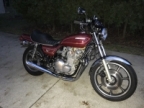- Posts: 4168
- Thank you received: 2387
A word of warning !!
- Wookie58
-
Topic Author
- Away
- Moderator
Lot's of you guys are fitting more and more electronic devices to your bikes (ignition modules, instruments, system controllers etc) so I thought it made sense to cover this topic - the old motto "better safe than sorry" comes to mind as diagnosing the potential issues that can be caused by using "un-protected" relays with electronics will catch out even the most experienced enthusiast
These relays have the resistor or diode to block "reverse voltage spikes" when you turn them off - sounds strange I know but the winding in a relay generates a magnetic field (just like an ignition coil) which when turned off inducts a voltage (same as a coil secondary/HT)
I have included a screen shot from an oscilloscope which shows a regular 4 pin autoparts store relay inducing a momentary spike of nearly 400v
This is the potential scenario if not using a protected relay with electronics
You fit your new gizmo with a regular relay - turn it on, works great - turn it off - turn it back on and it doesn't work (the 400v back EMF has fried it) so you do your checks, relay works, wiring is all good so "gizmo" must be faulty. Take it back to the store and get a new "gizmo" fit it, turn it on, happy days, turn it off and "poof" new gizmo is fried
Do your checks, wiring is ok maybe a "bad ground" no that's ok - so back to the store. Store guy is not happy to replace another gizmo but does begrudgingly. You take it home fit it and guess what happens next !!!!!!!!!!!! This time store guy tells you to f#*k off
Please Log in or Create an account to join the conversation.
- howardhb
-

- Offline
- Sustaining Member
- God, I trust
- Posts: 448
- Thank you received: 469
I routinely use 1N4001 or 1N4007 diodes.
H.
'81 GPz 550 D1
'81 GPz 1100 B1 ELR "Tribute" www.kzrider.com/our-forum/11-projects/61...-elr-tribute?start=0
'82 Yamaha YB100 Fizzie
'79 Suzuki GT200 X5 TWO STROKE TWIN - SMOKER!
Please Log in or Create an account to join the conversation.
- F64
-

- Offline
- User
- 81-KZ440D2
- Posts: 1117
- Thank you received: 401
I have to throw a diode on my starter solenoid and horn relay soon.
I was just looking at a video last night concerning this.
Here's a video from EEVblog discussing the issue.
81-KZ440-D2.
Louis Dudzik's GM HEI ignitor conversion installed 2015 s3.amazonaws.com/gpzweb/Ignition/GPZgmHEImod.html
Motogadget m-unit blue installed 2017.
LIC, NY
Please Log in or Create an account to join the conversation.
- Mikaw
-

- Offline
- Sustaining Member
- Posts: 4831
- Thank you received: 1847
1976 KZ 900 A4 kzrider.com/forum/11-projects/613548-1976-kz-900-a4
1976 KZ 900 B1 LTD
1978 KZ 1000 B2 LTD
1980 KZ 750 E1
Kowledge Speaks, But Wisdom Listens.
Jimi Hendrix.
Please Log in or Create an account to join the conversation.
- F64
-

- Offline
- User
- 81-KZ440D2
- Posts: 1117
- Thank you received: 401
81-KZ440-D2.
Louis Dudzik's GM HEI ignitor conversion installed 2015 s3.amazonaws.com/gpzweb/Ignition/GPZgmHEImod.html
Motogadget m-unit blue installed 2017.
LIC, NY
Please Log in or Create an account to join the conversation.
- Mikaw
-

- Offline
- Sustaining Member
- Posts: 4831
- Thank you received: 1847
With the one you posted you need to be mindful of coil polarity?In Wookie's photo between 85 and 86 is a coil. You are correct.
The one below has a built in diode.
1976 KZ 900 A4 kzrider.com/forum/11-projects/613548-1976-kz-900-a4
1976 KZ 900 B1 LTD
1978 KZ 1000 B2 LTD
1980 KZ 750 E1
Kowledge Speaks, But Wisdom Listens.
Jimi Hendrix.
Please Log in or Create an account to join the conversation.
- F64
-

- Offline
- User
- 81-KZ440D2
- Posts: 1117
- Thank you received: 401
There is a "+" sign next to the 86 terminal.
81-KZ440-D2.
Louis Dudzik's GM HEI ignitor conversion installed 2015 s3.amazonaws.com/gpzweb/Ignition/GPZgmHEImod.html
Motogadget m-unit blue installed 2017.
LIC, NY
Please Log in or Create an account to join the conversation.
- Wookie58
-
Topic Author
- Away
- Moderator
- Posts: 4168
- Thank you received: 2387
Good spot Mikaw (I must have been having a senior moment with that diagram) this is what a relay with resistor looks likeI thought the symbol between 85-86 was a coil. Are you saying it’s indicating a diode?
Please Log in or Create an account to join the conversation.
- slmjim+Z1BEBE
-

- Offline
- User
- Enjoy Life! IT HAS AN EXPIRATION DATE!
- Posts: 1228
- Thank you received: 726
Low voltage DC solenoids are all over those devices, some of which are quite robust. All have spike suppression diodes built in where they can't be seen except as a small lump under the coil wrap, or in the schematic. Those diodes serve exactly the same purpose; to keep spikes caused by the field collapsing through the coil from spiking voltage & current back into the control PCB's.
I've never seen a resistor as spike suppressor across a coil in that type of equipment, only diodes. What is the value of the resistor? Seems it would add undesireable load.
Good Ridin'
slmjim
A biker looks at your engine and chrome.
A Rider looks at your odometer and tags.
1973 ('72 builds) Z1 x2
1974 Z1-A x2
1975 Z1-B x2
1993 CB 750 Nighthawk x2
2009 ST1300A
www.kawasaki-z-classik.com
An enthusiast's forum focused exclusively
on all things Z1, Z2 and KZ900.
Please Log in or Create an account to join the conversation.
- Wookie58
-
Topic Author
- Away
- Moderator
- Posts: 4168
- Thank you received: 2387
I don't know the value of the resistor unfortunately, only that it is greater than the resistance of the relay coil. Because it is in "parallel" with the relay coil and electricity is lazy, under normal operating conditions the current passes through the relay coil (the path of least resistance) so any load increase is negligibleslmjim here. Twenty+ years career in photocopier & printer hardware before moving into print / scan / fax Network Analyst arena.
Low voltage DC solenoids are all over those devices, some of which are quite robust. All have spike suppression diodes built in where they can't be seen except as a small lump under the coil wrap, or in the schematic. Those diodes serve exactly the same purpose; to keep spikes caused by the field collapsing through the coil from spiking voltage & current back into the control PCB's.
I've never seen a resistor as spike suppressor across a coil in that type of equipment, only diodes. What is the value of the resistor? Seems it would add undesireable load.
Good Ridin'
slmjim
Please Log in or Create an account to join the conversation.
- slmjim+Z1BEBE
-

- Offline
- User
- Enjoy Life! IT HAS AN EXPIRATION DATE!
- Posts: 1228
- Thank you received: 726
Seems the spike would conduct through the coil instead of the resistor then? Perhaps the device printed as a rectangle across the coil on the relay cover is in fact a a diode, but is represented as a generic symbol? Although the relay posted doesn't indicate coil polarity as does the one F64 shows. Feel like I'm missing something obvious...
I don't know the value of the resistor unfortunately, only that it is greater than the resistance of the relay coil. Because it is in "parallel" with the relay coil and electricity is lazy, under normal operating conditions the current passes through the relay coil (the path of least resistance) so any load increase is negligibleslmjim here. Twenty+ years career in photocopier & printer hardware before moving into print / scan / fax Network Analyst arena.
Low voltage DC solenoids are all over those devices, some of which are quite robust. All have spike suppression diodes built in where they can't be seen except as a small lump under the coil wrap, or in the schematic. Those diodes serve exactly the same purpose; to keep spikes caused by the field collapsing through the coil from spiking voltage & current back into the control PCB's.
I've never seen a resistor as spike suppressor across a coil in that type of equipment, only diodes. What is the value of the resistor? Seems it would add undesireable load.
Good Ridin'
slmjim
Good Ridin'
slmjim
A biker looks at your engine and chrome.
A Rider looks at your odometer and tags.
1973 ('72 builds) Z1 x2
1974 Z1-A x2
1975 Z1-B x2
1993 CB 750 Nighthawk x2
2009 ST1300A
www.kawasaki-z-classik.com
An enthusiast's forum focused exclusively
on all things Z1, Z2 and KZ900.
Please Log in or Create an account to join the conversation.
- Wookie58
-
Topic Author
- Away
- Moderator
- Posts: 4168
- Thank you received: 2387
Hi Jim, please see below
Seems the spike would conduct through the coil instead of the resistor then? Perhaps the device printed as a rectangle across the coil on the relay cover is in fact a a diode, but is represented as a generic symbol? Although the relay posted doesn't indicate coil polarity as does the one F64 shows. Feel like I'm missing something obvious...
I don't know the value of the resistor unfortunately, only that it is greater than the resistance of the relay coil. Because it is in "parallel" with the relay coil and electricity is lazy, under normal operating conditions the current passes through the relay coil (the path of least resistance) so any load increase is negligibleslmjim here. Twenty+ years career in photocopier & printer hardware before moving into print / scan / fax Network Analyst arena.
Low voltage DC solenoids are all over those devices, some of which are quite robust. All have spike suppression diodes built in where they can't be seen except as a small lump under the coil wrap, or in the schematic. Those diodes serve exactly the same purpose; to keep spikes caused by the field collapsing through the coil from spiking voltage & current back into the control PCB's.
I've never seen a resistor as spike suppressor across a coil in that type of equipment, only diodes. What is the value of the resistor? Seems it would add undesireable load.
Good Ridin'
slmjim
Good Ridin'
slmjim
Please Log in or Create an account to join the conversation.
